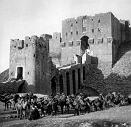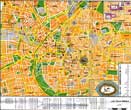| |
Introduction
Now Aleppo or Halab with 3 million people (2000), it is Syria's second largest city 193 kilometres north of Homs and 350 kilometres north of Damascus. It is the capital of Aleppo governorate, NW Syria, and it is a commercial centre located in a semi-desert region. In the Aleppo city there is a big Turkish /Armenian community who are mainly Christian. There is also a large Russian community. This can be seen by the numerous Russian signs that adorn many shops. Aleppo, has an international airport and is accessible, via train with other cities and countries.
Historically it is said that Abraham was camping on the acropolis* which, long before his time, served as the foundation of fortress (where the Aleppo citadel is standing now) and he milked (Halab) his Grey cow there. This is how Aleppo got the name of "Halab al-Shahba"
Aleppo is famous for its citadel that towers over it. Traditionally a city of trade, especially before the Suez canal, it used to link Europe and India. A truly charming oriental city. Aleppo is the city of Architecture. One can find various styles in it; architectures of the XIII th. and XIV th. centuries, like the caravanserais, coranic schools and Hammams (so called Turkish baths), in the old city. Architecture of the XVI th. and XVII th. centuries, in the residencies of the delicate bourgeoisie of the Jdayde quarter, with its magnificent stone engravings. Baroque Architecture of XIX th. and the beginning of the XX th. centuries, in the Azizyeh quarter (e.g. la Villa Rosa). The new chic 'Shahba' quarter is a mixture of several styles, i.e. Neo -Classic, Norman, Oriental, etc. You can even find some Chinese pagodas. Aleppo is built entirely from stone.
History
The city was inhabited perhaps as early as the 6th millennium B.C and competes with Damascus on being the oldest inhabited city in the world. It appeared in the Hittite archives in central Anatolia and in the archives of Mari on the Euphrates. In the 14th-13th cent. B.C. it was controlled by the Hittites. Later, Aleppo was a key point on the major caravan route across Syria to Baghdad (Iraq). From the 9th to the 7th cent. B.C. it was mostly ruled by Assyria and was known as Halman. It was later (6th cent. B.C.) held by the Persians and Seleucids. In 333 BC, Aleppo was taken over by Alexander the Great, and was kept under the Greeks for 300 years in the form of the Seleucid Empire. During this time Aleppo was an important trading city, between the Euphrates and Antioch. Seleucus I (d. 280 B.C.) rebuilt much of the city, renaming it Berea. The city's commercial importance was enhanced by the fall of Palmyra .In 64 BC Pompey brought Syria under Roman domination. It remained under Roman control in the form of the Byzantine Empire and was a major centre of Christianity, and huge cathedral was built in it (which is still standing) until 637AD, when the Arabs took over in; subsequently, In 944 Aleppo was taken over by the Hamdani's whose made it virtually independent of the Abbasid Caliphate. Under the first Hamadanid Seif al-Daula (who built Aleppo's famous citadel) the city enjoyed great prosperity and fame in science, literature and medicine, despite this leader's military ambitions. Mention should be made of the two most prominent poets, al-Mutanabbi and Abu al-Firas; of the philosopher and scientist, al-Farabi the foremost Arab thinker before Avicenna; and of the linguist, Ibn Kahlaweh, all of who lived in Sayf al-Dawla's court and were renowned for great knowledge and scholarship.
It was unfortunate for Seif al-Daula that at the end of his reign his Byzantine opponent should have been the capable Emperor Nicephorus Phocas. Successive Greek invasions gave the dynasty no chance to get a secure footing and soon after the Emir's death the brilliance passed away. In 962 AD it was retaken by the Byzantine Empire and in 1098, it was circled by soldiers from the First Crusade who could not conquer it, but paralyzed its commercial power. It was besieged again in 1124 by another Crusade, and then taken over by Zengi and his successor Nur al Din, and Saladin captured it in 1183, making it his stronghold. At the death of Saladin the Ayyubid dynasty was perpetuated in Aleppo. At the Mameluke period, trade was diverted from Aleppo to the North in Antioch and to the South through Palmyra. But when the Mongol Empire under Hulagu Khan (1260) and by Timur (1401) broke up and some converted to Islam, trade resumed through Aleppo. In 1517 the Ottoman Empire annexed Aleppo, which then became a great commercial city. From 1832 to 1840 it was held by Muhammad Ali of Egypt. In the late 19th cent., Aleppo's importance declined as Damascus grew and the Suez Canal and other trade routes were developed. The city revived under French control after World War I and Aleppo's trade rose with the arrival of Armenian refugees, who fled the Ottoman massacres. But after France had given Antioch to Turkey, Aleppo lost its Mediterranean outlet. Nassiro Khosrau, the Persian traveller who visited the town as early as 1047, says that customs were then levied there on merchandise to and from the whole Middle East, and that merchants and traders from the surrounding lands restored there.
A Christian traveller at about the same time says that in the cloth bazaar alone goods to the value of 20,000 dinars changed hands daily. Neither was the discovery of the Cape route to India as fatal as might have been expected. The Levant company and the merchants of Marseilles and Venice, who established the town as the chief depot for European trade at the eastern end of the Mediterranean, maintained a very considerable activity. Even the opening of the Suez Canal was not quite as disastrous for Aleppo as for other caravan cities; the town could still tap the traffic of regions to the north and east which remained comparatively unaffected by the new developments. Main attractions and historical building
The attractions of the city of Aleppo is
- its 13th-century citadel witch it was built by Seif al-Daula al hamadani on the remains of earlier civilizations. The citadel's fortified entrance is a marvellous example of Arab military architecture. On the north and south sides, great towers rise above the moat. This moat, 20 meters deep and 30 meters wide, emphasized the fortress's proud isolation. The main parts of the citadel are: The throne room, the bathroom, the small mosque (Ibrahim's mosque).
- 12th-century Great Mosque or Al-Jami al-Kabir (was built by the Umayyad dynasty witch is one of the largest mosques in the world). The great mosque built in 1213 whose square minaret is 21 meters high and from which can be seen a splendid view
- Souqs (Old Markets): In terms of spaciousness and originality, the covered souqs of Aleppo, which extend for more than 10 kilometres, are the most striking in any Islamic city. The souqs are named after the various crafts: hence, we find the souq of gold, the souq of copper, cotton, etc. Traditionally, there is always a fountain in the centre and sometimes a little garden planted with jasmine and roses. Most of these souqs date back to the 15th century. They are living museum, which depict medieval life
- Commercial Khans (caravanserais): The Khans are in the same area as the souqs, since they were used for the accommodation of traders and their goods. Their beautiful facades and entrances characterize these Khans; their high arches and portified wooden doors. Some of these Khans are Banadiqa Khan, 'Banadiqa' in Arabic being the term of 'inhabitants of Venice', Jumruk Khan (customs), Wazir Khan (minister) and Saboun Khan (Soap).
- Various 17th-century medersas (Old schools), churches, palaces, hammams (public bath houses), ancient houses, some dating back to the 15th century, like the al-Bunduqiah (Venetian) Consulate, which contains superb ornaments and antiquities.
- Other attractions to the city of Aleppo include, the National Museum or Archaeological Museum witch contains exhibits from the stone age to modern times. It has particularly interesting collection of antiquities from some of the most ancient sites in Syria including Mari, Ugarit, and Ebla, as well as objects found in the Euphrates Basin,Hama, Tell Halaf and Ein Dara, in addition to remains from Greek, Roman, Arab and Islamic periods. - More attractions are the Museum of Popular Tradition and the Baron Hotel. The Baron Hotel has seen the likes of US President Theodore Roosevelt, Aviator Charles Lindbergh, Kemal Attaturk (founder of Turkey), Lady Louis Mountbatten, author Agatha Christie and her archaeologist husband Sir Max Mallowan. None more famous than T.E. Lawrence of Arabia, whose rooms are available.
|
|







